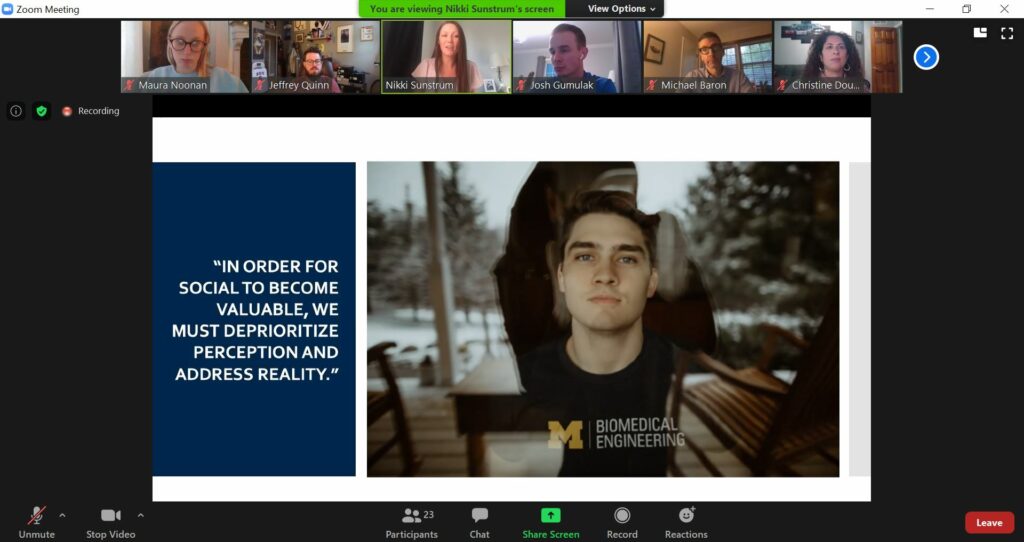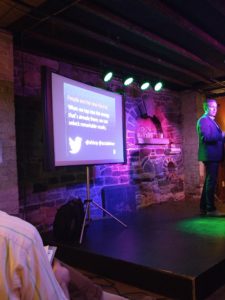From crafting all those tongue-in-cheek emails and social media posts to shooting video and photos at our events, AAF Buffalo’s secretary is a true jack of all trades. Read on to learn about the man, the myth, the guy who bedazzled his own shirt for this year’s American Advertising Awards: Dan Nesselbush.
 Let’s hear about your day job.
Let’s hear about your day job.
Where do you work, and what does your role entail?
I work in downtown Buffalo for CBRE|Buffalo, an affiliate of a global commercial real estate firm as the marketing manager. I support an office of a dozen brokers by executing all of their marketing needs – press releases, website management, writing copy, photographing properties, deploying email and direct mail campaigns, and more – it’s truly an all-encompassing position when you work in a small office.
What advice do you have to give to emerging talent in your field?
Take initiative and never stop learning. A lot of the day-to-day tasks I work on are things I never learned in college. Actively reading and trying new things is not only necessary to keep a fresh perspective but it’s also sometimes the only way to keep up. Upper management won’t always spoon-feed professional development opportunities to you.
Tell us about organizations/charities that you’re passionate about.
AAF Buffalo has occupied a lot of my time the past few years as a member of the executive board so that’s obviously something I’m passionate about. Having a long history with the area, I’ve put most of my effort into seeing that AAF Buffalo continues to strengthen its stance as a place where anyone interested in a career in marketing communications can go to further their career. I’m a firm believer that people with the tools and support that an organization like this can provide is the ultimate way to contribute to a growing economy that provides our neighbors with the best opportunity to realize success.
What was your first job?
My first job out of college was as sports producer at WKBW-TV. I had the pleasure of getting a paycheck covering some of my favorite teams while getting to work alongside some of the best in the broadcast business under the tutelage of John Murphy and Jeff Russo. My true first job was in high school, slinging popcorn behind the concession stand at a movie theater. A winning combination of minimum wage, free movie tickets, and a sweet maroon vest.
When you’re not working, how do you spend your time (hobbies, side projects, etc.)?
In my free time I’ve taken on photography as a hobby/side project. Combining my love for visual communication and my journalism experience I started freelancing as a photojournalist for some local publications the last few years, including regular assignments for the Bee Group Newspapers. Some of my work can be seen at my site www.theworkingdan.com
What’s the last thing you read?
“Yes, And.” It’s a book about managing business and creative teams using improv techniques from the guys who run The Second City, the world-famous comedy group out of Chicago.
What’s your favorite restaurant?
It’s unfair to pick one restaurant when there are so many great options in Buffalo. I’m going to take the easy way out and just give my “best wings in Buffalo” candidate of Mammoser’s Tavern in Hamburg.
What’s your favorite hidden gem in WNY?
I’m not divulging my hidden gem for fear that it will become trendy and ruined by everyone else.
Now, let’s talk a little about AAF Buffalo.
Why did you join AAF Buffalo?
It’s as simple as wanting more for my career. I was subject to layoff twice in my early career, working for companies that have gone through bankruptcy and acquisition. I also worked directly with a lot of people who didn’t always understand or value the role of marketing in the business model. I joined AAF Buffalo because it provided professional development and the opportunity to speak with peers passionate about the type of work we do that I just wasn’t able to get where I was working.
What has been your proudest moment in your role on the AAF board?
I’d have to say the AAF Club Achievement Awards we received this past spring are the proudest. We worked hard the last few years to evolve our programming and communications efforts and to have the folks at the national level determine that we were worthy of first place was a great validation for the effort put in by everyone.
How has AAF Buffalo impacted you professionally?
AAF Buffalo has given me the opportunity to take on a leadership role and work with creative people who have become friends over the years. These are people I probably would have never been able to meet if I never showed up to an event or run for the board. Meeting and speaking with our out-of-town guests who bring great insight from beyond our area has also made a huge impact – sometimes it’s the simple validation you are on the same page as someone from a larger or different market is all it takes to make a positive mark on your career.
What differentiates AAF Buffalo from other groups?
I think it’s how active the organization is. The mix of out-of-town voices, a juried competition with the ADDYs, a handful of student opportunities, and a fun mix of social events really makes it an easy group to become a part of.
Why would you encourage others to join AAF Buffalo?
It’s a great mix of industry professionals who perform a variety of tasks in their day to day. There is something about being around creative people who work on some amazing things and share the common struggles many of us face in our careers. AAF Buffalo can be whatever you want it to be. A place to build a network of friends. A place to be inspired. A place to collaborate. A place to complain about your current workplace. A place to find your next employee. A place to sneak around the HR person to meet the person at the agency you want to work for. A place to give back to the community. A place to just grab a beer and do some bowling (shameless plug – I love our holiday bowling tournament). The opportunities are endless.
Keep up with Dan on Twitter at @dnesselbush, or Instagram at theworkingdan.
 The prominence of social media has not only altered the way in which we communicate personally, it has reshaped the information we consume, distorted emotional responses, and manipulated the visual identities of its users. In an ever-connected world, everyone struggles to balance competing priorities, remain engaged, and retain authenticity.
The prominence of social media has not only altered the way in which we communicate personally, it has reshaped the information we consume, distorted emotional responses, and manipulated the visual identities of its users. In an ever-connected world, everyone struggles to balance competing priorities, remain engaged, and retain authenticity.


 Let’s hear about your day job.
Let’s hear about your day job.
 All that is great, but you know what is even greater? The iconic movie The Goonies from 1985, which is exactly what Anthony used to start off his talk. Hundreds of people each year travel to visit the house featured in the film. No one told them to do this (in fact the home owner did not want visitors), it just happened organically. The point is, you can’t force people to love something. Instead of trying to create a cult following or a viral moment – as so many brands are wishing for daily – tap into existing energy and use that to your advantage. Ask yourself: What do people already care about? Where is the energy already and how can you tap into it?
All that is great, but you know what is even greater? The iconic movie The Goonies from 1985, which is exactly what Anthony used to start off his talk. Hundreds of people each year travel to visit the house featured in the film. No one told them to do this (in fact the home owner did not want visitors), it just happened organically. The point is, you can’t force people to love something. Instead of trying to create a cult following or a viral moment – as so many brands are wishing for daily – tap into existing energy and use that to your advantage. Ask yourself: What do people already care about? Where is the energy already and how can you tap into it? The second example was “The Dress”: Did you see it as white and gold or black and blue? This argument caused everyone to freak out in 2015, and many brands tried to jump on this bandwagon. Anthony pointed out one company that was able to successfully use The Dress to their advantage in a campaign –
The second example was “The Dress”: Did you see it as white and gold or black and blue? This argument caused everyone to freak out in 2015, and many brands tried to jump on this bandwagon. Anthony pointed out one company that was able to successfully use The Dress to their advantage in a campaign – 